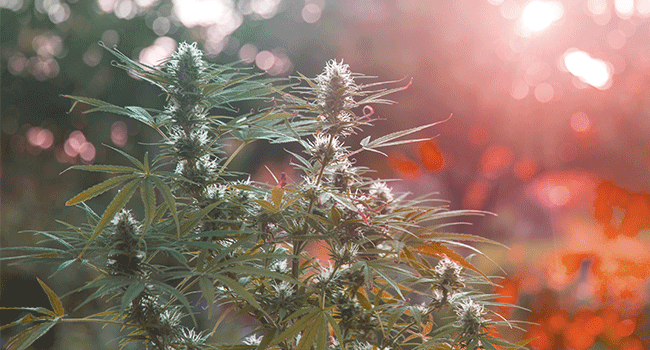Growing Autoflowering Cannabis Outdoors
Published : Dec 23, 2019

In this guide to growing autoflowering cannabis outdoors, we'll cover the benefits and particulars, as well as how to do it successfully. Finally, we'll discuss the pros and cons of choosing autoflowering seeds vs feminized seeds for outdoor grows.
With each new generation of seeds, autoflowering cannabis becomes more potent, higher-yielding and better-tasting, without compromising speed. Today, most of these hybrids are just as good as photoperiod strains. This makes them extremely popular among indoor growers, and most people—including us—recommend cultivating them indoors.
However, growing autoflowering cannabis outdoors is totally doable. Use this helpful guide to learn why, how, and when to use automatic genetics outside, as well as what advantages they have over photoperiod seeds and clones.
 WHY SHOULD YOU GROW AUTOFLOWERING CANNABIS OUTDOORS?
WHY SHOULD YOU GROW AUTOFLOWERING CANNABIS OUTDOORS?
Growing autoflowering cannabis indoors gives you total control over the environmental conditions your plants are exposed to, including the total amount of light they receive each day. This is the key to consistent harvests and potency. However, there are several reasons some growers choose to cultivate automatic strains outside.
 BIGGER YIELDS
BIGGER YIELDS
Indoor growers maximise yields by packing as many plants as they can fit into their available space, as well as by increasing the amount of artificial light in their tent or grow room. Alternatively, some growers use high-stress training techniques to coax out greater harvests.
However, growing autoflowering cannabis under the sun will usually give you higher yields per individual plant. If you've purchased expensive automatic seeds and want to get the most out of each one, you may want to try an outdoor grow.
 LESS EQUIPMENT
LESS EQUIPMENT
If you don't have the space or the money to invest in a fully equipped grow room, growing autoflowering cannabis outside is a good idea. You'll still have to buy good soil and nutrients, but you won't have to factor in the cost of lighting, ventilation, or filtration.
 SMALLER SIZE
SMALLER SIZE
Photoperiod strains can get massive outdoors. It's not unusual for them to exceed 3m in height if the weather is warm and sunny for most of the summer. That's fine if you don't have to hide your grow, but it's a major concern if you do.
Autoflowering cannabis, on the other hand, finishes so fast that it rarely has time to get taller than 1m before harvest. You can easily shield an autoflowering plant from view by placing it behind a fence or hedge. The smell might still reveal your secret garden, but you won't have to worry as much about prying eyes.
 PERFORMS WELL IN ANY CLIMATE
PERFORMS WELL IN ANY CLIMATE
From the northernmost latitudes to tropical regions, growing autoflowering cannabis plants outdoors has certain advantages.
In cooler regions with short, damp summers, automatic strains ripen quickly, meaning mature buds can be harvested before an early freeze or a wet autumn. This protects your herb from loss due to rot, mildew, and mould.
In more temperate regions, you can easily reap multiple harvests per growing season when cultivating autoflowering cannabis outdoors. This practice allows you to enjoy cured herb well before any photoperiod plants begin to flower, and autumn harvests let you stock up for winter.
Of course, if you live in an area where the winters are particularly mild, or non-existent, you may be able to grow autoflowering plants outside all year long for a steady supply.
 LESS RISK OF DAMAGE DUE TO MOULD OR PESTS
LESS RISK OF DAMAGE DUE TO MOULD OR PESTS
Because autoflowering plants have such a short lifespan, they're less exposed to the conditions that support mould, pests, diseases, etc. This is true whether you grow inside or outside, but you have much less control in the great outdoors. If you've had a problem with mites, aphids, mould, powdery mildew, or bud rot when growing more traditional strains outside, give autoflowering cannabis a try.
 PERFECT FOR GUERRILLA GROWS
PERFECT FOR GUERRILLA GROWS
Autoflowering strains are extremely hardy and require very little care. They don't need to be trained, and they mature in just two months after germination, on average. That makes them perfect for guerrilla grows.
Find a remote spot that sees little traffic with good access to water, prepare the soil, and plant your autoflowering seeds. If the local wildlife likes to munch on young cannabis shoots, take precautions to shield them from damage using chicken wire or the like. After 8–9 weeks, your plants will be ready for the chop.
WHEN TO START AN OUTDOOR AUTOFLOWERING GROW
Autoflowering cannabis plants, like their photoperiod cousins, prefer strong sunlight when grown outside. They will flower even when exposed to 18–24 hours of light per day, but they need at least 10–12 hours of strong sunlight to produce good yields. Autoflowers can tolerate cold temperatures, but they're not freeze-proof. That's why the best time to start your outdoor autoflowering grow depends on where you live.
 EXTREME NORTH
EXTREME NORTH
You can grow cannabis anywhere south of the North Pole, but the further north you go, the shorter the growing season will be. If you live in the far north, plant your seeds outdoors as soon as all danger of frost is over, somewhere between April and June.
If you plant your autoflowering seeds in June, you should be able to harvest in August. This timing avoids the worst of the cold, damp weather that develops as autumn approaches. By keeping the flowers as dry as possible, you minimise the risk of failure due to mould, mildew, and rot.
In the extreme north, you'll only be able to fit one outdoor grow per season, even with autoflowering strains.
 MILDER AREAS
MILDER AREAS
If you grow weed a little further south, you can fit in two outdoor autoflowering grows per summer with proper planning. Start the first between late April and early May for a late July harvest. Immediately reseed, and the second crop should be ready before the end of October.
Keep an eye out for heavy fall rains and early frosts. It may be necessary to cover your second run with a tarp, buckets, or other protective material to protect the fragile flowers from harm in the last week or two.
 MEDITERRANEAN REGIONS
MEDITERRANEAN REGIONS
If you live in a tropical region between the equator and the Mediterranean, you shouldn't have any frost to worry about. That means you can grow autoflowering cannabis outdoors all year long. If you grow back-to-back, that translates to four or more harvests annually.
Of course, as you get closer to the equator, the total hours of sunlight each day will also get closer to 12 year-round. Although they will produce flowers with as few as 10 hours of strong sunlight per day, autoflowering strains prefer at least 16 hours for the best yield and potency. Grow sites very close to the equator may not be optimal for all breeds of automatic cannabis.
 HOW TO GROW AUTOFLOWERING CANNABIS OUTSIDE
HOW TO GROW AUTOFLOWERING CANNABIS OUTSIDE
Growing autoflowering cannabis outdoors is very similar to growing from photoperiod seeds, but there are some slight differences. In short: growing autos is usually easier, and eliminates some of the more stressful factors associated with cultivation.
 GATHER THE NECESSARY SUPPLIES
GATHER THE NECESSARY SUPPLIES
This list details the basic supplies you'll need for an outdoor autoflowering cannabis grow:
- Autoflowering seeds
- Pots or grow bags, unless you're planting in the ground
- Soil
- Nutrients
- pH test kit
- Bucket or watering can
 CHOOSE A SITE
CHOOSE A SITE
Pick a spot for your garden. If you're planting in the ground, make sure your autoflowering cannabis will get as much sunlight as possible. View the site from all sides to ensure your plants aren't easy to see. Even if discretion isn't a concern due to legal reasons, you should take the possibility of theft into consideration. Plant close to a water source so you don't have to tote heavy buckets of fluid frequently.
If you're planting in containers, the site isn't as much of a concern because you can move your plants as needed. Invest in a wheeled plant dolly to make it easier to move the pots as the plants get larger.
 PREPARE THE SOIL
PREPARE THE SOIL
Purchase a high-quality organic soil mix, unless you prefer to make your own. This can be used to either fill containers or refill holes if you grow in the ground. In either case, good soil is key to growing any type of cannabis successfully.
 GERMINATE YOUR AUTOFLOWERING SEEDS
GERMINATE YOUR AUTOFLOWERING SEEDS
You can germinate your autoflowering seeds in the same way you germinate photoperiod seeds: the paper towel method, root cubes, or sowing seeds directly in soil. As long as they're fresh, most autoflowering seeds will germinate within a few days. Even older seeds rarely take more than a week.
Once germinated, carefully place your seeds in the ground or in their final pot. Unlike photoperiod plants, autoflowers prefer not to be up-potted (transplanted into progressively bigger pots).
 WATER AND FEED AS NEEDED
WATER AND FEED AS NEEDED
As the young autoflowering plants grow, water and feed as necessary. Because this type of cannabis develops much faster than photoperiod strains, they may become thirsty or hungry faster than more light-sensitive breeds. On the other hand, you definitely don't want to overwater or overfeed. Oftentimes, autos can be fed half-strength nutrients and will still produce impressive harvests in good conditions.
Unless you're trying a guerrilla grow, check your young plants daily for signs that they require fluids or nourishment. As a rule of thumb, use plain water at least once between feedings. As autoflowering plants get larger, they may need to be watered daily, especially if they're planted in pots or the weather has been particularly dry.
When feeding or watering, always check the pH level of the solution. Adjust as necessary to keep the value between 6.0 and 7.0 pH.
 WATCH FOR MOULD & PESTS
WATCH FOR MOULD & PESTS
Autoflowering strains mature so quickly that they largely mitigate the threat of mould and pests—but you can't eliminate these problems entirely.
When you check to see if your autoflowering plants need to be watered or fed, give them a quick once-over for other problems. At the first sign of mould, remove the infected bud or foliage and relocate your plants to a drier area.
Visible pests like mites and worms can be plucked off by hand if the problem is minimal. Otherwise, try a safe pesticide like neem oil or insecticidal soap. These sprays can also be used weekly to prevent infestations. Just make sure not to spray directly on the buds.
 HARVEST WHEN RIPE
HARVEST WHEN RIPE
Each breeder will provide an expected harvest time from germination for their autoflowering seeds. This time may be the same whether the seed is grown indoors or out, or it may be slightly longer for outdoor grows.
Don't go strictly by the suggested time. Instead, watch for the trichomes to turn cloudy, for the pistils to change colour and shrink into the buds, and for the leaves to fade from green to yellow or purple.
When all the signs point to full maturity, it's time to cut, dry, and cure as you would for any other type of cannabis.
 AUTOFLOWERING SEEDS VS FEMINIZED SEEDS FOR OUTDOOR CANNABIS GROWS
AUTOFLOWERING SEEDS VS FEMINIZED SEEDS FOR OUTDOOR CANNABIS GROWS
Autoflowering seeds and feminized (photoperiod) seeds each have their pros and cons when grown outside.
On the positive side, autoflowering seeds grow quickly and need minimal care. On average, they reach full maturity in half the time it takes a photoperiod strain.
Autoflowering seeds have their drawbacks too. You can clone them, but there's really no point. They will be at the same point of maturity as their mother, so by the time they recover and start to grow again, they'll be at or close to their pre-programmed end of life, producing only a few small, fluffy flowers.
Speaking of recovery time, autoflowering cannabis plants don't have much time to bounce back if they do encounter a problem. Let them dry out too much, overfeed them, or allow them to become infested with pests, and they'll stall for weeks. However, their maturity point won't be extended. This can greatly impact both their potency and yield. With autoflowering seeds, much more than with feminized seeds, you need to get it right the first time.
When it comes to yield and potency, there's less of a gap between autos and traditional strains than there used to be. Breeders have discovered how to minimise the amount of ruderalis required, allowing them to preserve the final weight and THC of the other parent(s), while still keeping the autoflowering trait.

SUMMARY
Growing autoflowering cannabis outdoors can be a rewarding project when done right. Plan well in advance by choosing the best time to start your seeds and a good site with optimal light and water access. Monitor their progress so you can give them the right amount of water and nutrients, and so you can correct any problems immediately.
For your work and attention, you'll be rewarded with a generous amount of aromatic herb that's just as potent and tasty as weed grown from a similar photoperiod strain.






































